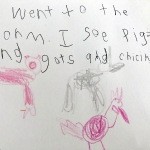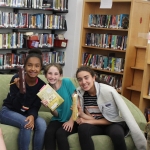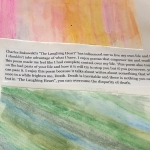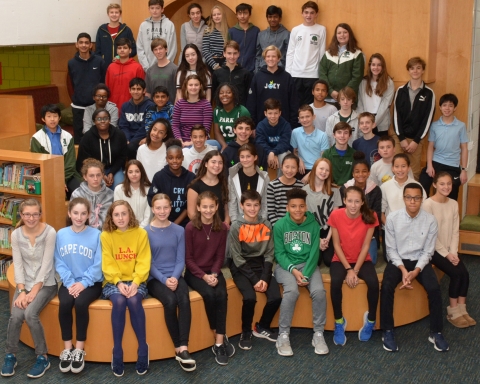What does a ten-year educational arc look like? Intuitively, we understand that children grow tremendously from age 4 to 14. Those ten years are truly transformational for children. To better understand the arc in application, we traced a single strand as children grow up at Park: literacy.
Lower Division
by Young Ju Rhee, Park Parent Editorial Board
In the Lower Division, the literacy program is based on a systematic and multisensory approach. Phonological skills first begin to develop in the PreK and Kindergarten years. Those young students start to recognize and produce rhymes, isolate initial and final sounds, as well as recognize and write some of them.
 As with all skill development, the range of proficiency at this young age can be wide. While there is a set sequential phonics program which spans Kindergarten to Grade 2, teachers and literacy specialists are able to meet these young learners at their ‘just right’ level, and challenge them individually.
As with all skill development, the range of proficiency at this young age can be wide. While there is a set sequential phonics program which spans Kindergarten to Grade 2, teachers and literacy specialists are able to meet these young learners at their ‘just right’ level, and challenge them individually.
 In my household this spring, we have been observing the exciting, rather sudden, but of course all intended, fits and starts of “Learning to Read” by my own Kindergartner. The concentration that he demonstrates as he uses blends (“sh- or ch-”) or high frequency words (“that, the, from”) as he reads short sentences at this stage means he is more focused on decoding and encoding the sentences, rather than absorbing the meaning or deciphering the storyline based on the pictures. Those things will all come together in time, with greater speed and comprehension. This process pushes young children to become wholistic readers, making sense of the information in the books through pictures, re-telling stories, and sharing emotions and reactions in the exploration of books.
In my household this spring, we have been observing the exciting, rather sudden, but of course all intended, fits and starts of “Learning to Read” by my own Kindergartner. The concentration that he demonstrates as he uses blends (“sh- or ch-”) or high frequency words (“that, the, from”) as he reads short sentences at this stage means he is more focused on decoding and encoding the sentences, rather than absorbing the meaning or deciphering the storyline based on the pictures. Those things will all come together in time, with greater speed and comprehension. This process pushes young children to become wholistic readers, making sense of the information in the books through pictures, re-telling stories, and sharing emotions and reactions in the exploration of books.
 By the third and fourth grade, “Learning to Read” transitions to “Reading to Learn.” Reading Workshop and Book Clubs allow for students in the Middle Division to become more skilled in absorbing the content in the books of their appropriate reading levels. Some books are assigned specifically by classroom teachers, while the librarians also help students choose books that match their interests, or suggest genres or topics that students may not have considered before. Eight- and nine-year-olds, in particular, tend to read one genre, or books by the same author. Instead, students are encouraged to read “Just Right books,” which are books that they can read with speed, and are also able to answer these questions: “Can I read but also understand? Can I tell someone about the story? How do I feel about the character and stories?”
By the third and fourth grade, “Learning to Read” transitions to “Reading to Learn.” Reading Workshop and Book Clubs allow for students in the Middle Division to become more skilled in absorbing the content in the books of their appropriate reading levels. Some books are assigned specifically by classroom teachers, while the librarians also help students choose books that match their interests, or suggest genres or topics that students may not have considered before. Eight- and nine-year-olds, in particular, tend to read one genre, or books by the same author. Instead, students are encouraged to read “Just Right books,” which are books that they can read with speed, and are also able to answer these questions: “Can I read but also understand? Can I tell someone about the story? How do I feel about the character and stories?”
 As students get older and begin to move through the grades, the home-school connection is critical because students can share their answers to these questions in class as well as at home. Even more, with encouragement to read as part of their daily homework, readers are also writing more about the reading they are doing. Good readers use multiple skills in inferring character, such as by identifying with both Opal and the dog in Because of Winn Dixie in third grade, or empathizing with events and people in the non-fiction genre related to immigration topics studied in fifth grade. It is easy to trace the literacy program through Park’s Learning Arc beginning with nascent readers in PreK and K and ending with the confident learners who are building skills and finding their voices through books.
As students get older and begin to move through the grades, the home-school connection is critical because students can share their answers to these questions in class as well as at home. Even more, with encouragement to read as part of their daily homework, readers are also writing more about the reading they are doing. Good readers use multiple skills in inferring character, such as by identifying with both Opal and the dog in Because of Winn Dixie in third grade, or empathizing with events and people in the non-fiction genre related to immigration topics studied in fifth grade. It is easy to trace the literacy program through Park’s Learning Arc beginning with nascent readers in PreK and K and ending with the confident learners who are building skills and finding their voices through books.
Upper Division
by Carol Batchelder, Park Parent Editorial Board
“In the Upper Division, we capitalize on our students’ elementary preparation, producing flexible thinkers, engaged learners, and competent and curious scholars.” ~ Scott Young
 As students progress through the arc, literacy, like all subjects, gets turned up a notch in the Upper Division. Students first encounter this new level of intellectual challenge with required summer reading. In addition to grade-level requirements, all Upper Division students choose one of four “Community Read” books. In September, when they return to school, sixth, seventh, and eighth graders are placed in randomly assigned book groups with lively discussions led by eighth graders.
As students progress through the arc, literacy, like all subjects, gets turned up a notch in the Upper Division. Students first encounter this new level of intellectual challenge with required summer reading. In addition to grade-level requirements, all Upper Division students choose one of four “Community Read” books. In September, when they return to school, sixth, seventh, and eighth graders are placed in randomly assigned book groups with lively discussions led by eighth graders.
There are numerous instances of these threads which help form the infrastructure of Park’s PreK-8 education and shape Park’s learning arc. Once the ideas and skills take root, then students can apply and present them coherently and progress becomes more evident. This defines the Upper Division phase of the arc. The following portrays some actual examples showing how it plays out based on conversations with numerous faculty members including Upper Division English teachers Susan Bogue-Myslik and Curt Miller.
 Active Reading: Building upon the reading skills developed in the younger grades, Upper Division students acquire new skills like active reading. Sixth graders study the novel Roar of Thunder, Hear my Cry, “marking passages for inferences and themes while learning how to purposefully engage in active reading,” according to Susan Bogue Myslik. The following year, seventh graders experience the value of active reading when it’s time to take cumulative exams.
Active Reading: Building upon the reading skills developed in the younger grades, Upper Division students acquire new skills like active reading. Sixth graders study the novel Roar of Thunder, Hear my Cry, “marking passages for inferences and themes while learning how to purposefully engage in active reading,” according to Susan Bogue Myslik. The following year, seventh graders experience the value of active reading when it’s time to take cumulative exams.
Personal Essays: Sixth graders are asked to reflect on moments of courage in their own lives by taking part in the Max Warburg National Curriculum project, culminating with students writing their own Personal Courage Essays. Two years later, eighth graders learn about belief systems by studying This I Believe essays. Susan explains that “they then compose their own versions, expanding the breadth and scope of their writing skills while drawing upon the analysis, research capabilities, and personal experiences they have already acquired.”
Persuasive Writing: As fifth graders, students dive into persuasive writing, learning the art of supporting a belief or argument with conviction. Eighth graders then expand on this skill as they work towards mastering fully developed thesis statements with the persuasive essay writing skills they have developed. Whether put forth to back-up an argument, conduct seminar-style discussions about a book, or write an argument to justify their own opinion about who the main protagonist is in Romeo and Juliet, their persuasive writing abilities mature and advance as they do and are applied throughout Grade 8 and beyond.
 Poetry: Sixth graders embark on a poetry unit after years of exposure to this art form in various ways during their early years at Park, creating poetry and exploring different types of figurative language and styles. In seventh grade, students study the poems of others and learn to understand, appreciate, and interpret various styles and voices, grasp symbolism, and comprehend how the complexity of form can add meaning, while applying all those types of figurative language from sixth grade. This poetry thread culminates in eighth grade when students create their own anthology of poetry, ultimately selecting and annotating ten poems to present as essential. Susan explains that this project is “as much about analyzing themselves – who they are, what is important to them, what is important to others, and how art/literature/poetry can help us all make sense of those identities as it is about analyzing the poetry.” Talk about learning threads!
Poetry: Sixth graders embark on a poetry unit after years of exposure to this art form in various ways during their early years at Park, creating poetry and exploring different types of figurative language and styles. In seventh grade, students study the poems of others and learn to understand, appreciate, and interpret various styles and voices, grasp symbolism, and comprehend how the complexity of form can add meaning, while applying all those types of figurative language from sixth grade. This poetry thread culminates in eighth grade when students create their own anthology of poetry, ultimately selecting and annotating ten poems to present as essential. Susan explains that this project is “as much about analyzing themselves – who they are, what is important to them, what is important to others, and how art/literature/poetry can help us all make sense of those identities as it is about analyzing the poetry.” Talk about learning threads!
As students progress through the Learning Arc, they encounter dozens of connections tying together the building blocks of literacy. These learning threads are evident in every corner of our school even beyond the core subjects and into the arenas of leadership, athletics, the arts, which form a vast basis of knowledge. Scott Young explains, “a foundation of knowledge is the application of critical thinking and synthesis.” By the end of eighth grade, Park graduates are ready to launch to their next schools with confidence and a solid understanding of who they are and what they need to be well-prepared high school students. It is no secret, and Secondary School Counselor Lisa DiAdamo concurs, that secondary schools seek Park students because they are both academically prepared and ready to be leaders on their next campuses. How can they not be after embarking on the intentional, robust, and comprehensive journey that is the Park Learning Arc.





